Water Table Control for Increasing Yield and Saving Water in Cranberry Production
Abstract
:1. Introduction
2. Experimental Section

| Characteristic | Site A | Site B | Site C |
|---|---|---|---|
| General information | |||
| Location | 46°16′ N–71°57′ W | 46°17′ N–71°59′ W | 46°16′ N–72°01′ W |
| Production | Conventional | Organic | Organic |
| Bed properties | |||
| Number of beds | 6 | 3 | 3 |
| Dimensions of one bed (m × m) | 457 × 46 | 479 × 52 | 404 × 52 |
| Subsurface Drainage | |||
| Spacing (m) | 11.4 | 15.2 | 15.2 |
| Depth (m) | 0.8 | 0.8 | 0.8 |
| Slope (%) | 0.07 | 0.13 | 0.15 |
| Sprinklers system | |||
| Sprinkler spacing (m) | 18 | 15 | 15 |
| Irrigation line spacing (m) | 15 | 18 | 18 |
| April | May | June | July | August | September | |
|---|---|---|---|---|---|---|
| Air Temperature (°C) | ||||||
| 2013 | 4.5 | 13.5 | 15.4 | 20.5 | 18.0 | 13.4 |
| 2014 | 3.9 | 12.3 | 18.2 | 19.8 | 18.4 | 13.7 |
| Ave 1981–2010 | 4.3 | 11.4 | 16.7 | 19.3 | 18.1 | 13.6 |
| GDD z | ||||||
| 2013 | 52 | 255 | 312 | 472 | 408 | 258 |
| 2014 | 30 | 229 | 376 | 460 | 409 | 264 |
| Ave 1981–2010 | 48 | 203 | 353 | 443 | 407 | 261 |
| Rainfall (mm) | ||||||
| 2013 | 38 | 153 | 126 | 87 | 144 | 118 |
| 2014 | 123 | 59 | 106 | 86 | 133 | 56 |
| Ave 1981–2010 | 66 | 106 | 127 | 130 | 119 | 112 |
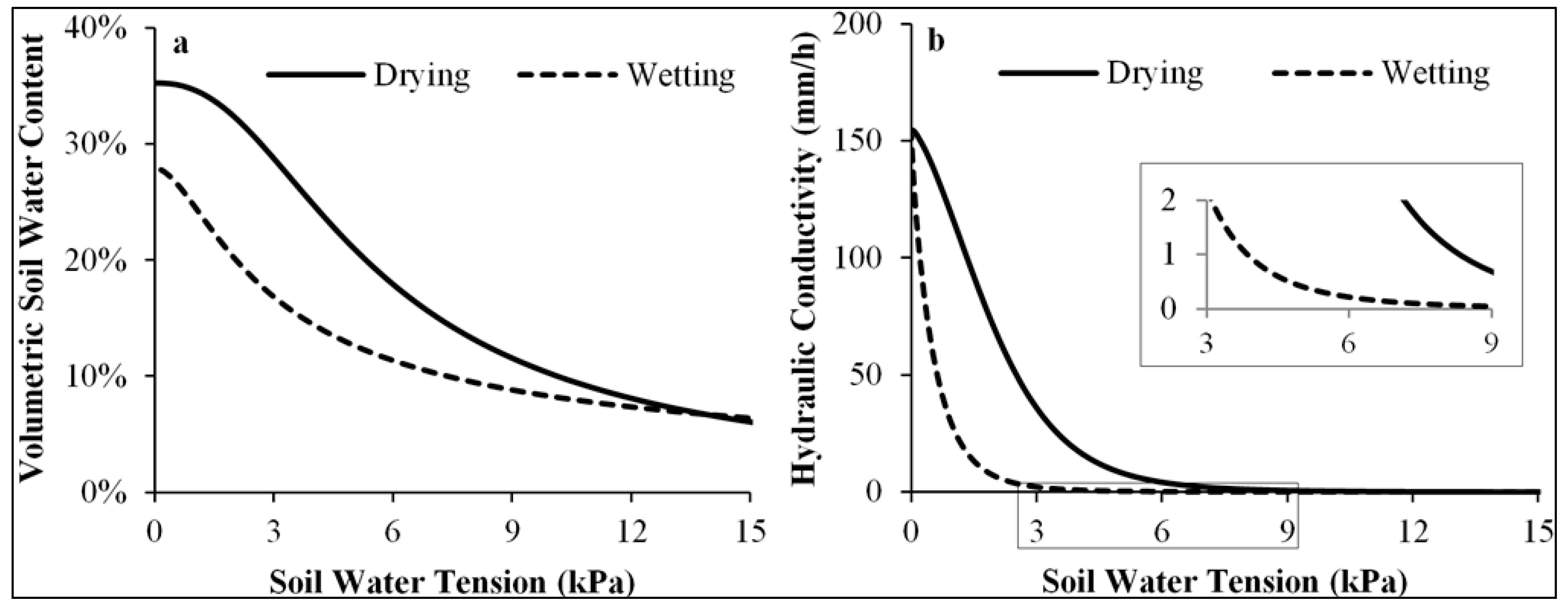
3. Results and Discussion
3.1. First Criterion: Increasing Yield without Decreasing Fruit Quality
3.1.1. Relationship between Yield and WTD
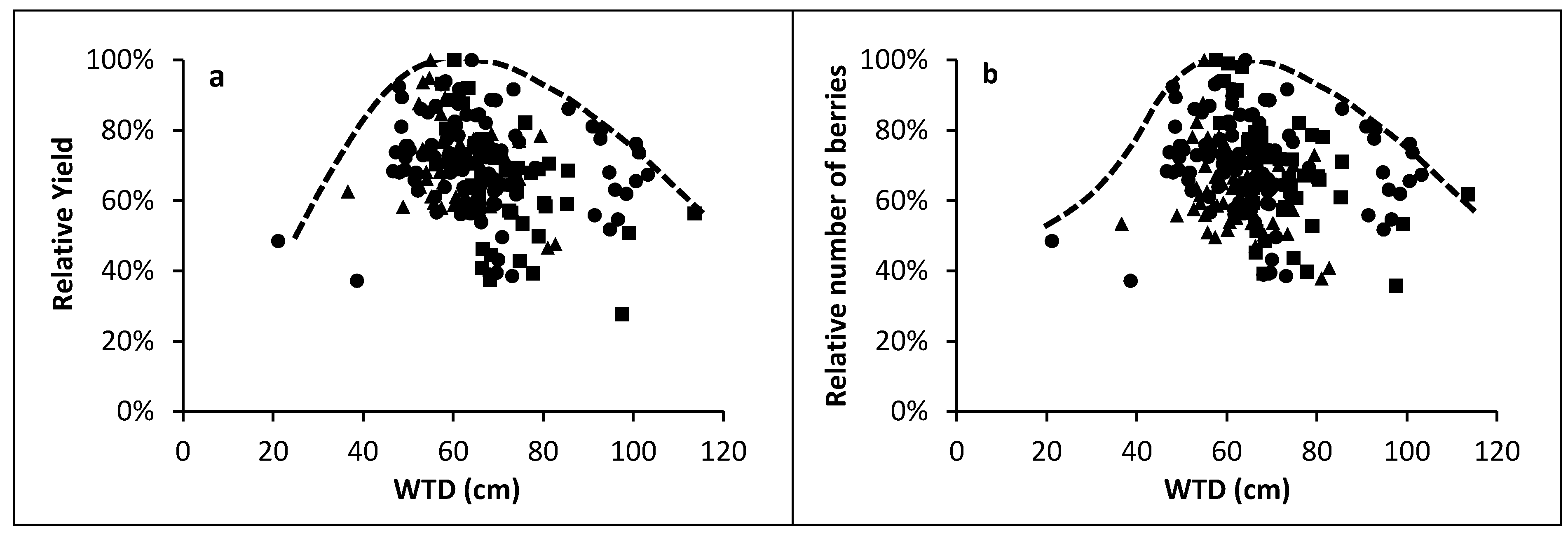
3.1.2. Mapping the WTD
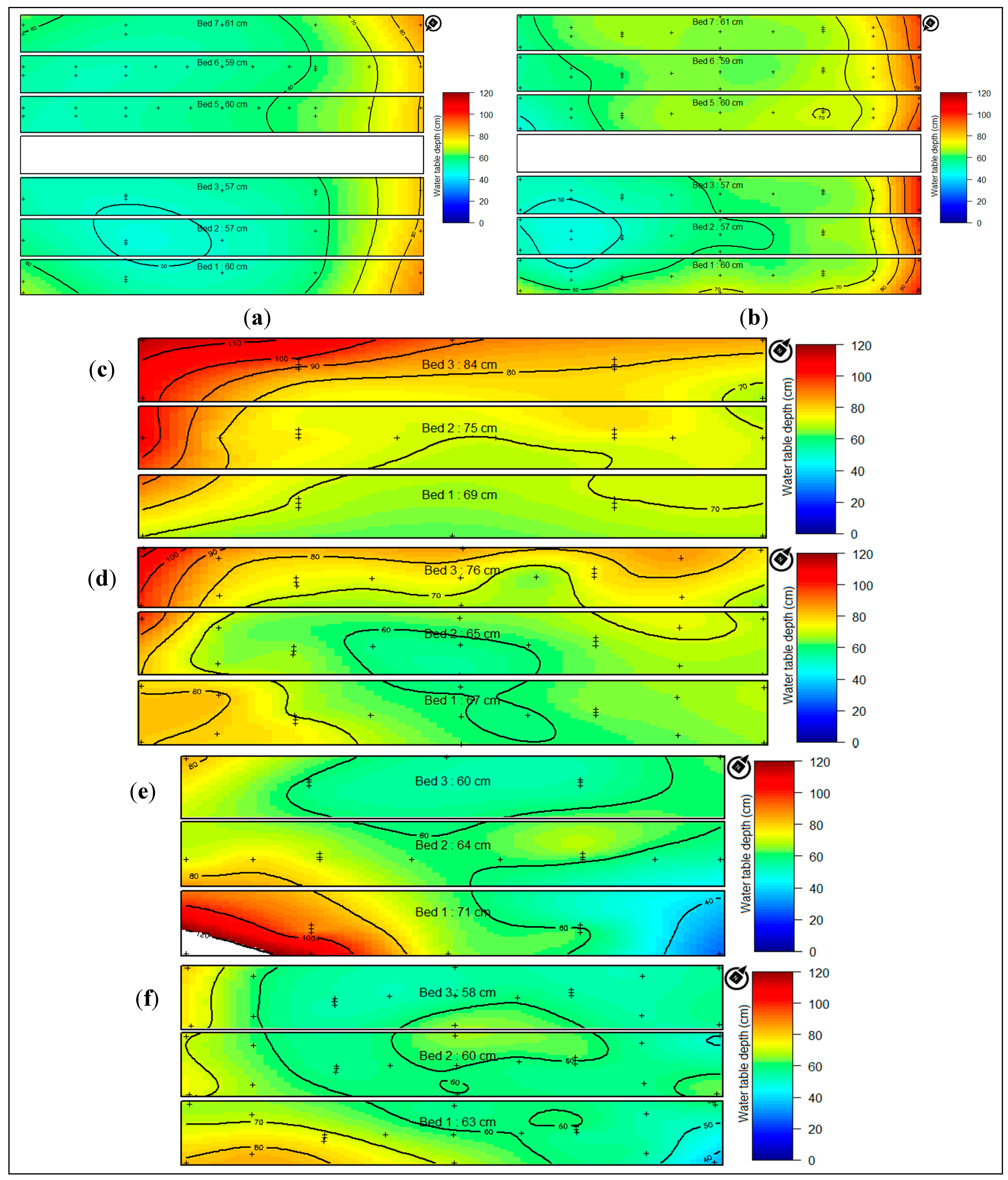
3.1.3. Mapping the Yield
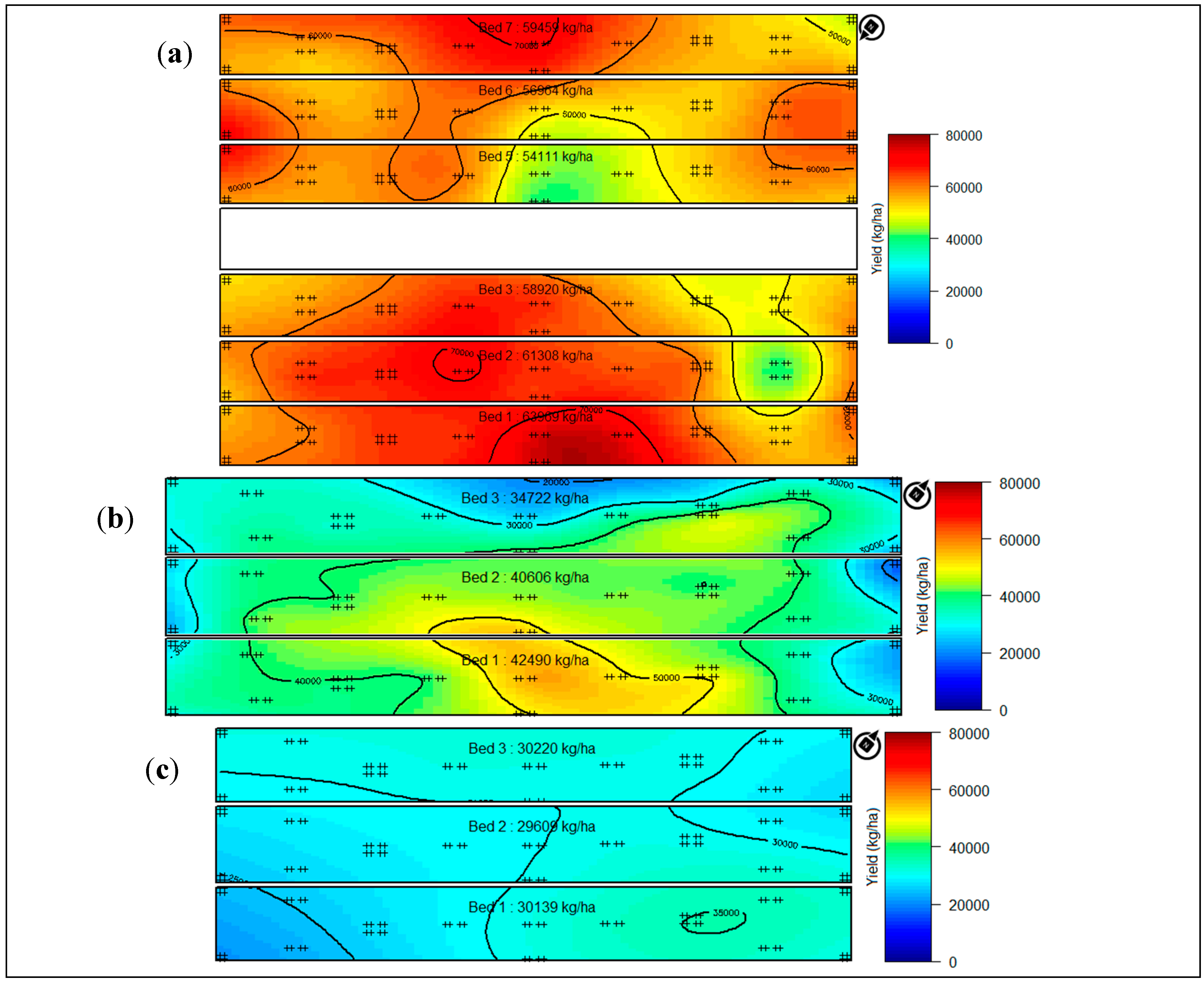
3.1.4. Yield Components

3.1.5. Fruit Quality Parameters
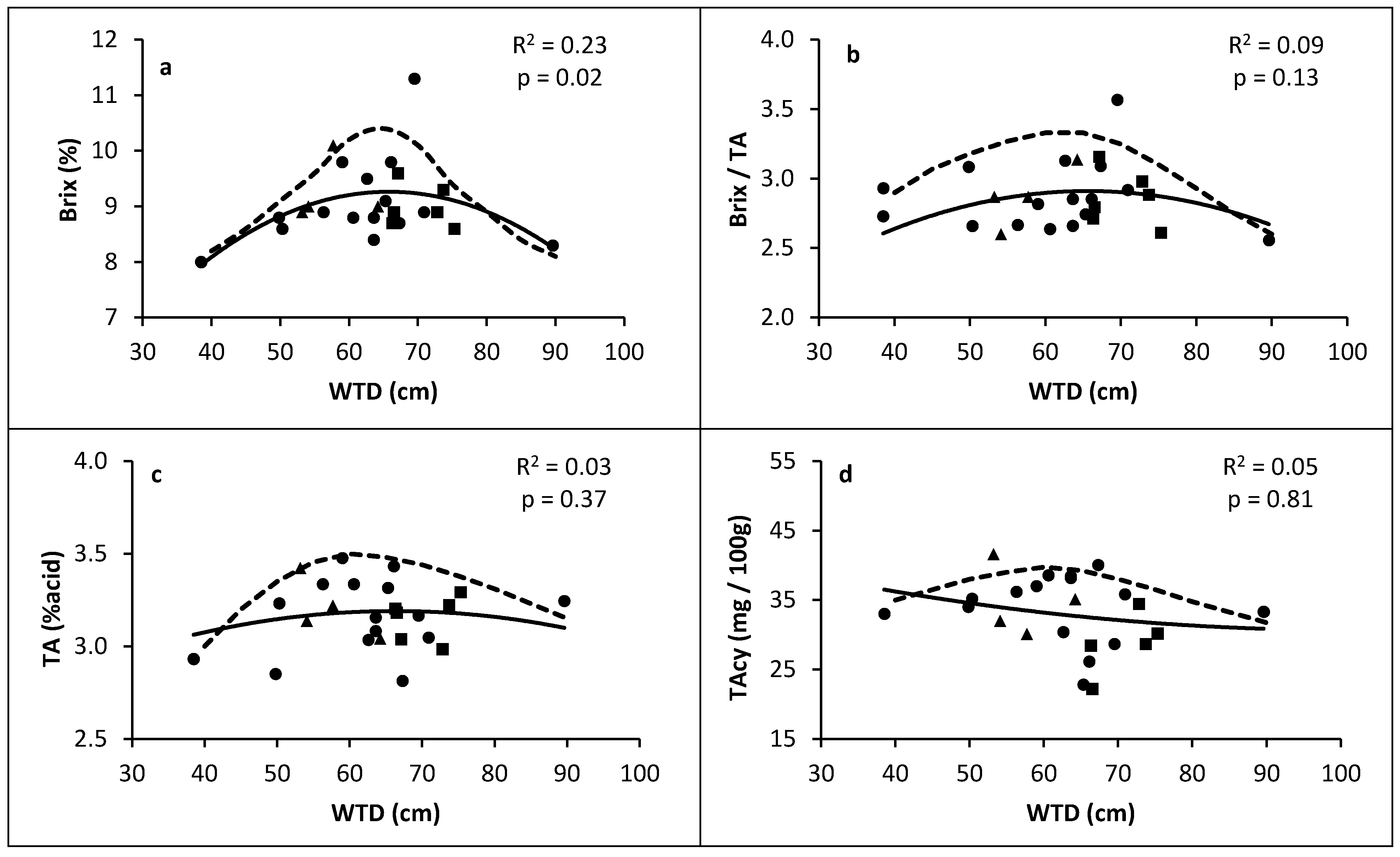
3.2. Second Criteria: Minimal Use of Sprinkler Irrigation
| Site | Beds | 2013 | 2014 | ||
|---|---|---|---|---|---|
| Irrigation (mm) | WTD (cm) | Irrigation (mm) | WTD (cm) | ||
| A | 1–5–7 | 36 | 52 ± 15 | 48 | 65 ± 16 |
| 2–3–6 | 24 | 58 ± 18 | 36 | 60 ± 16 | |
| B | 1–2 | 120 | 72 ± 9 | 72 | 66 ± 12 |
| 3 | 120 | 89 ± 12 | 168 | 75 ± 12 | |
| C | 1 West | 102 | 90 ± 12 | 144 | 75 ± 8 |
| 1 East–2–3 | 0 | 61 ± 9 | 24 | 58 ± 9 | |
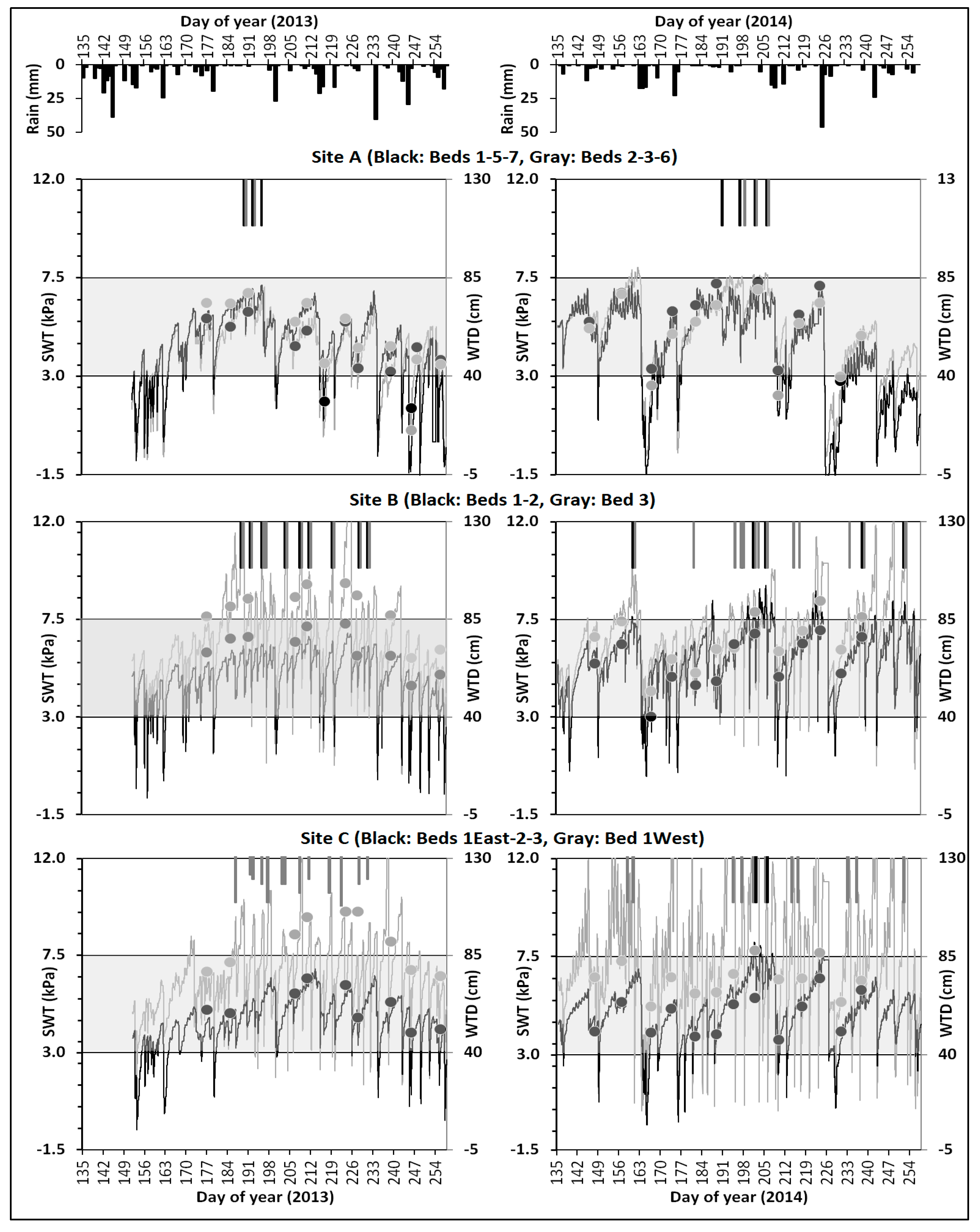
3.3. Third Criteria: Fast drainage
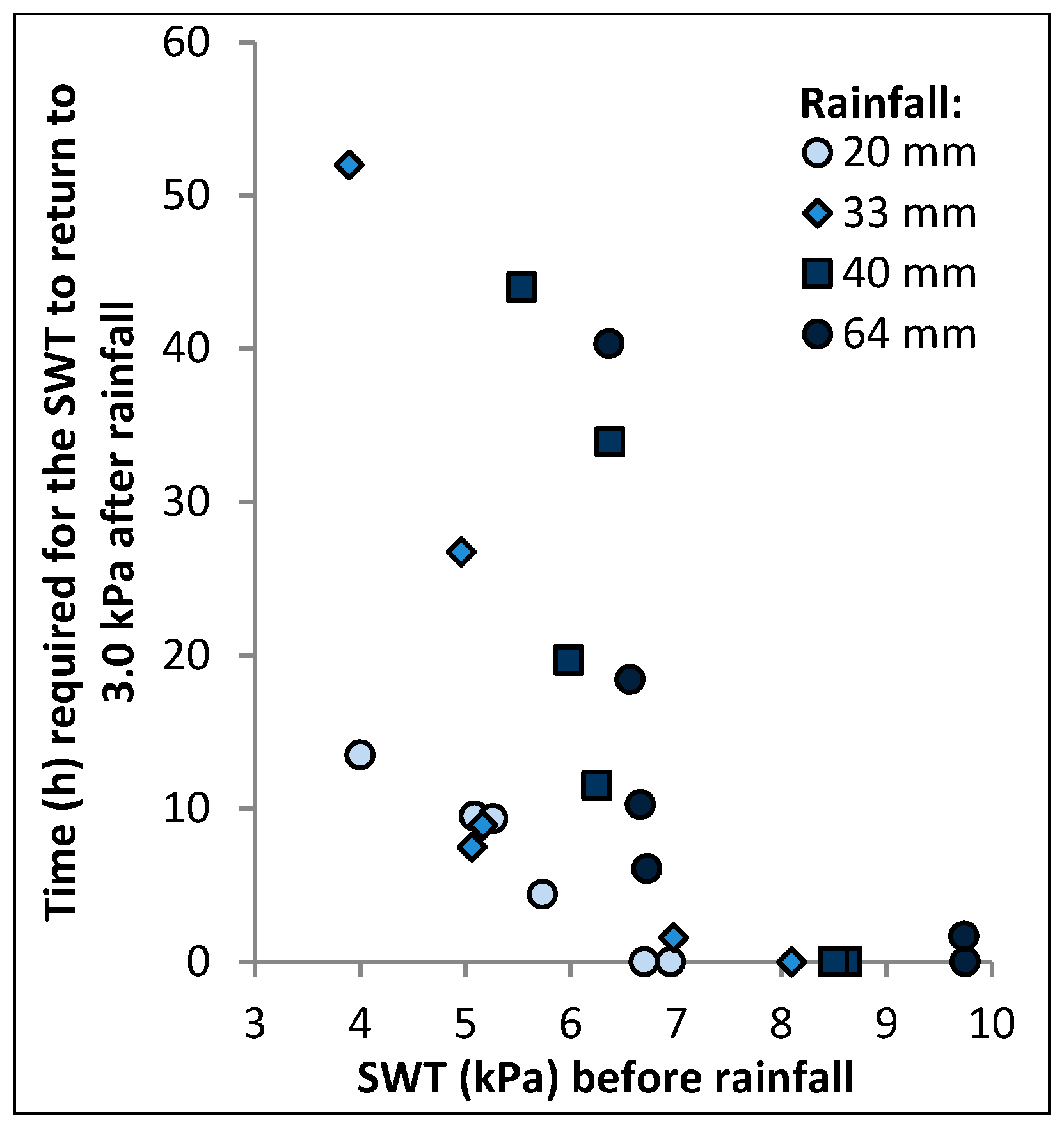
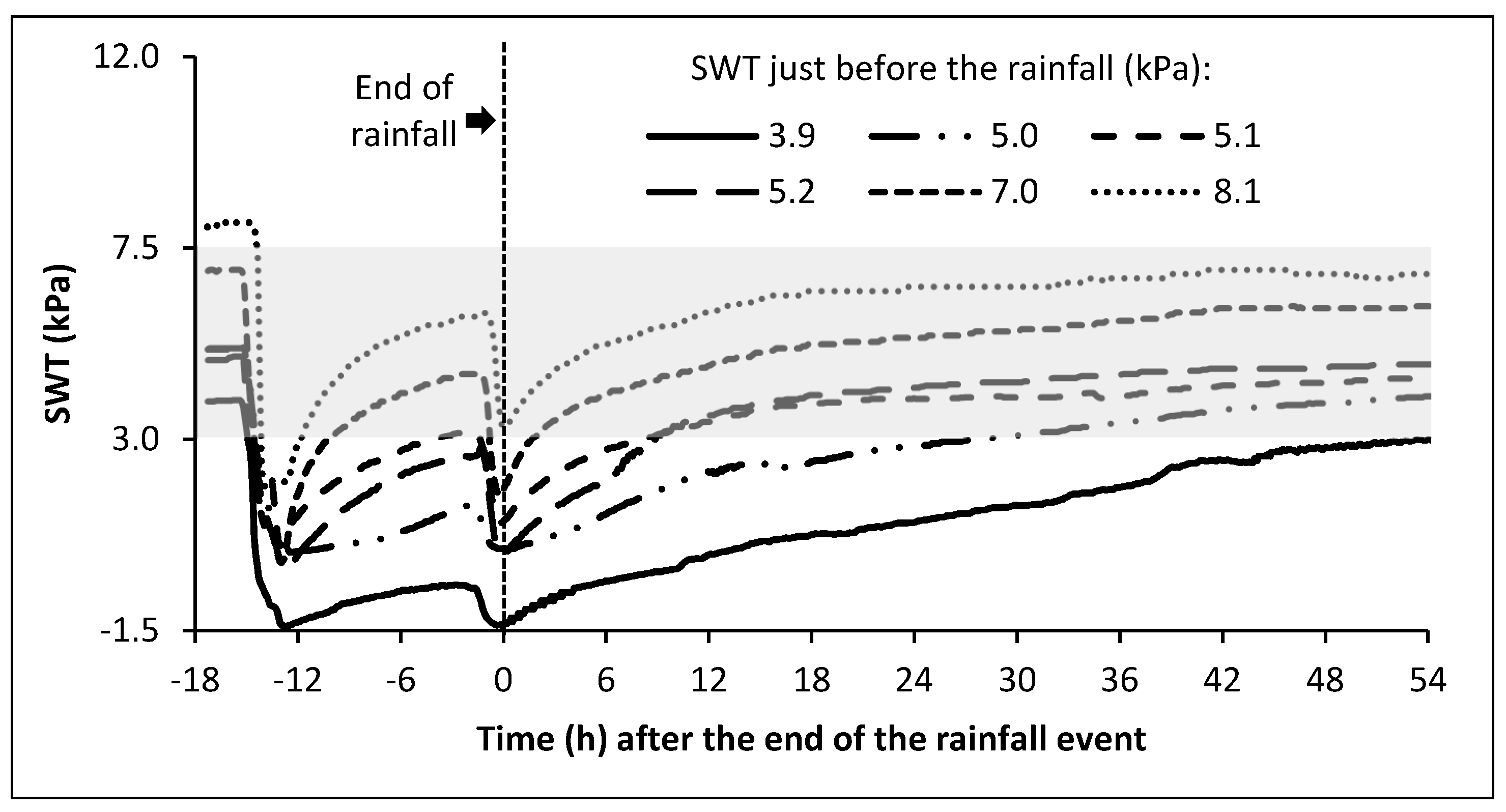
4. Conclusions
Acknowledgments
Author Contributions
Conflicts of Interest
References
- Faostat-Cranberries–Production of top 5 producers. Available online: http://faostat3.fao.org/browse/Q/QC/E (accessed on 21 May 2015).
- Eck, P. The American Cranberry; Rutgers University Press: New Brunswick, NJ, USA, 1990. [Google Scholar]
- Statistiques-Association des producteurs de canneberges. Available online: http://www.notrecanneberge.com/Industrie/Infos/statistiques.html (accessed on 21 May 2015).
- Pelletier, V.; Gallichand, J.; Caron, J.; Jutras, S.; Marchand, S. Critical irrigation threshold and cranberry yield components. Agric. Water Manag. 2015, 148, 106–112. [Google Scholar]
- Pelletier, V.; Gallichand, J.; Caron, J. Effects of soil water potential threshold for irrigation on cranberry yield and water productivity. Trans. Am. Soc. Agric. Biol. Eng. 2013, 56, 1325–1332. [Google Scholar]
- Caron, J.; Pepin, S.; Bonin, S. Determination of irrigation set points for cranberries from soil and plant-based measurements. Can. J. Soil Sci. 2015. accepted. [Google Scholar]
- Hattendorf, M.J.; Davenport, J.R. Cranberry evapotranspiration. Hort Sci. 1996, 31, 334–337. [Google Scholar]
- Bland, W.L.; Loew, J.T.; Norman, J.M. Evaporation from cranberry. Agric. For. Meteorol. 1996, 81, 1–12. [Google Scholar]
- Laurent, T. Réponse de la canneberge (Vaccinium macrocarpon Ait.) à l’aération du sol. Master’s Thesis, Université Laval, Québec, QC, Canada, 2014. [Google Scholar]
- Elmi, A.; Madramootoo, C.; Handyside, P.; Dodds, G. Water requirements and subirrigation technology design criteria for cranberry production in Quebec, Canada. Can. Biosyst. Eng. 2010, 52, 1–8. [Google Scholar]
- Gumiere, S.J.; Lafond, J.A.; Hallema, D.W.; Périard, Y.; Caron, J.; Gallichand, J. Mapping soil hydraulic conductivity and matric potential for water management of cranberry: Characterisation and spatial interpolation methods. Biosyst. Eng. 2014, 128, 29–40. [Google Scholar]
- Mailhot, A.; Kingumbi, A.; Talbot, G.; Poulin, A. Future changes in intensity and seasonal pattern of occurrence of daily and multi-daily annual maximum precipitation over Canada. J. Hydrol. 2010, 388, 173–185. [Google Scholar]
- Samson, M.-E.; Caron, J.; Fortin, J. Impacts of low water potential on soil salinity and its effects on cranberry development. In Proceedings of North American Cranberry Researchers and Extension Workers Conference, Quebec City, QC, Canada, 25–28 August 2013.
- Madramootoo, C.A.; Helwig, T.G.; Dodds, G.T. Managing water tables to improve drainage water quality in Quebec, Canada. Trans. Am. Soc. Eng. 2001, 44, 1511–1519. [Google Scholar]
- Evans, R.O.; Gilliam, J.W.; Skaggs, R.W. Controlled Drainage Management Guidelines for Improving Drainage Water Quality. Available online: http://www.bae.ncsu.edu/programs/extension/evans/ag443.html (accessed on 21 May 2015).
- Baumann, D.L.; Workmaster, B.A.; Kosola, K.R. ‘Ben Lear’ and ‘Stevens’ cranberry root and shoot growth response to soil water potential. HortScience 2005, 40, 795–798. [Google Scholar]
- Hall, I.V. Cranberry growth as related to water levels in the soils. Can. J. Plant Sci. 1971, 51, 237–238. [Google Scholar]
- Handyside, P. Water Table Management for Cranberry Production on Sandy Soil and Peat Soils in Québec. Master’s Thesis, McGill University, Montréal, QC, Canada, 2003. [Google Scholar]
- Eck, P. Cranberry growth and production in relation to water table depth. J. Am. Soc. Hortic. Sci. 1976, 101, 544–546. [Google Scholar]
- Fuleki, T.; Francis, F.J. Quantitative methods for anthocyanin: Extraction and determination of total anthocyanin in cranberries. J. Food Sci. 1968, 33, 72–77. [Google Scholar]
- Webb, R.A. Use of the boundary line in the analysis of biological data. J. Hortic. Sci. 1972, 47, 309–319. [Google Scholar]
- Marchand, S.; Parent, S.-E.; Deland, J.-P.; Parent, L.-E. Nutrient signature of Quebec (Canada) cranberry (Vaccinium macrocarpon Ait.). Rev. Bras. Frutic. 2013, 35, 292–304. [Google Scholar]
- Brown, A.O.; McNeil, J.N. Fruit production in cranberry (Ericaceae: Vaccinium macrocarpon): A bet-hedging strategy tooptimize reproductive effort. Am. J. Bot. 2006, 93, 910–916. [Google Scholar]
- Birrenkott, B.A.; Henson, C.A.; Stang, E.J. Carbohydrate levels and the development of fruit in cranberry. J. Am. Soc. Hortic. Sci. 1991, 116, 174–178. [Google Scholar]
- Hagidimitriou, M.; Roper, T.R. Seasonal changes in non-structural carbohydrates in cranberry. J. Am. Soc. Hortic. Sci. 1994, 119, 1029–1033. [Google Scholar]
- Nemon, N.A.; von Hoyningen Huene, B.; Gallichand, J.; Broughton, R.S. Subsurface irrigation and drainage on sandy soil in Southern Quebec. Can. Agric. Eng. 1987, 29, 137–142. [Google Scholar]
- Nosetto, M.D.; Jobbágy, E.G.; Jackson, R.G.; Sznaider, G.A. Reciprocal influence of crops and shallow ground water in sandy landscapes of the Inland Pampas. Fields Crop Res. 2009, 113, 138–148. [Google Scholar]
- Madramootoo, C.A.; Dodds, G.T.; Papadopoulos, A. Agronomic and environmental benefits of water-table management. J. Irrig. Drain. Eng. 1993, 119, 1052–1065. [Google Scholar]
- Pitts, D.J.; Tsai, Y.J.; Myhre, D.L.; Anderson, D.L.; Shih, S.F. Influence of water table depth on sugarcane grown in sandy soils in Florida. Trans. Am. Soc. Eng. 1993, 36, 777–782. [Google Scholar]
- Acevedo-Opazo, C.; Ortega-Farias, S.; Fuentes, S. Effects of grapevine (Vitis vinifera L.) water status on water consumption, vegetative growth and grape quality: An irrigation scheduling application to achieve regulated deficit irrigation. Agric. Water. Manag. 2010, 97, 956–964. [Google Scholar]
- Song, J.; Shellie, K.C.; Wang, H.; Qian, M.C. Influence of deficit irrigation and kaolin particle film on grape composition and volatile compounds in Merlot grape (Vitis vinifera L.). Food Chem. 2012, 134, 841–850. [Google Scholar]
- Lanari, V.; Palliotti, A.; Sabbatini, P.; Stanley Howell, G. Optimizing deficit irrigation strategies to manage vine performance and fruit composition of field-grown ‘Sangiovese’ (Vitis vinifera L.) grapevines. Sci. Hortic. 2014, 179, 239–247. [Google Scholar]
- Binet, M.; Asselin, R.; Laperrière, L.; Painchaud, J. Bulletin d’information sur la production écologique de la canneberge; Groupe HBA Experts-Conseils: Saint-Hyacinthe, QC, Canada, 1997; p. 40. (In French) [Google Scholar]
- Sandler, H.A.; DeMoranville, C.J.; Lampinen, B. Cranberry irrigation management. Available online: http://www.umass.edu/cranberry/downloads/Irrigation.pdf (accessed on 21 May 2015).
- Kahlown, M.A.; Ashraf, M.; Zia-ul-Haq. Effect of shallow groundwater table on crop water requirements and crop yields. Agric. Water Manag. 2005, 76, 24–35. [Google Scholar] [CrossRef]
© 2015 by the authors; licensee MDPI, Basel, Switzerland. This article is an open access article distributed under the terms and conditions of the Creative Commons Attribution license (http://creativecommons.org/licenses/by/4.0/).
Share and Cite
Pelletier, V.; Gallichand, J.; Gumiere, S.; Pepin, S.; Caron, J. Water Table Control for Increasing Yield and Saving Water in Cranberry Production. Sustainability 2015, 7, 10602-10619. https://doi.org/10.3390/su70810602
Pelletier V, Gallichand J, Gumiere S, Pepin S, Caron J. Water Table Control for Increasing Yield and Saving Water in Cranberry Production. Sustainability. 2015; 7(8):10602-10619. https://doi.org/10.3390/su70810602
Chicago/Turabian StylePelletier, Vincent, Jacques Gallichand, Silvio Gumiere, Steeve Pepin, and Jean Caron. 2015. "Water Table Control for Increasing Yield and Saving Water in Cranberry Production" Sustainability 7, no. 8: 10602-10619. https://doi.org/10.3390/su70810602
APA StylePelletier, V., Gallichand, J., Gumiere, S., Pepin, S., & Caron, J. (2015). Water Table Control for Increasing Yield and Saving Water in Cranberry Production. Sustainability, 7(8), 10602-10619. https://doi.org/10.3390/su70810602






